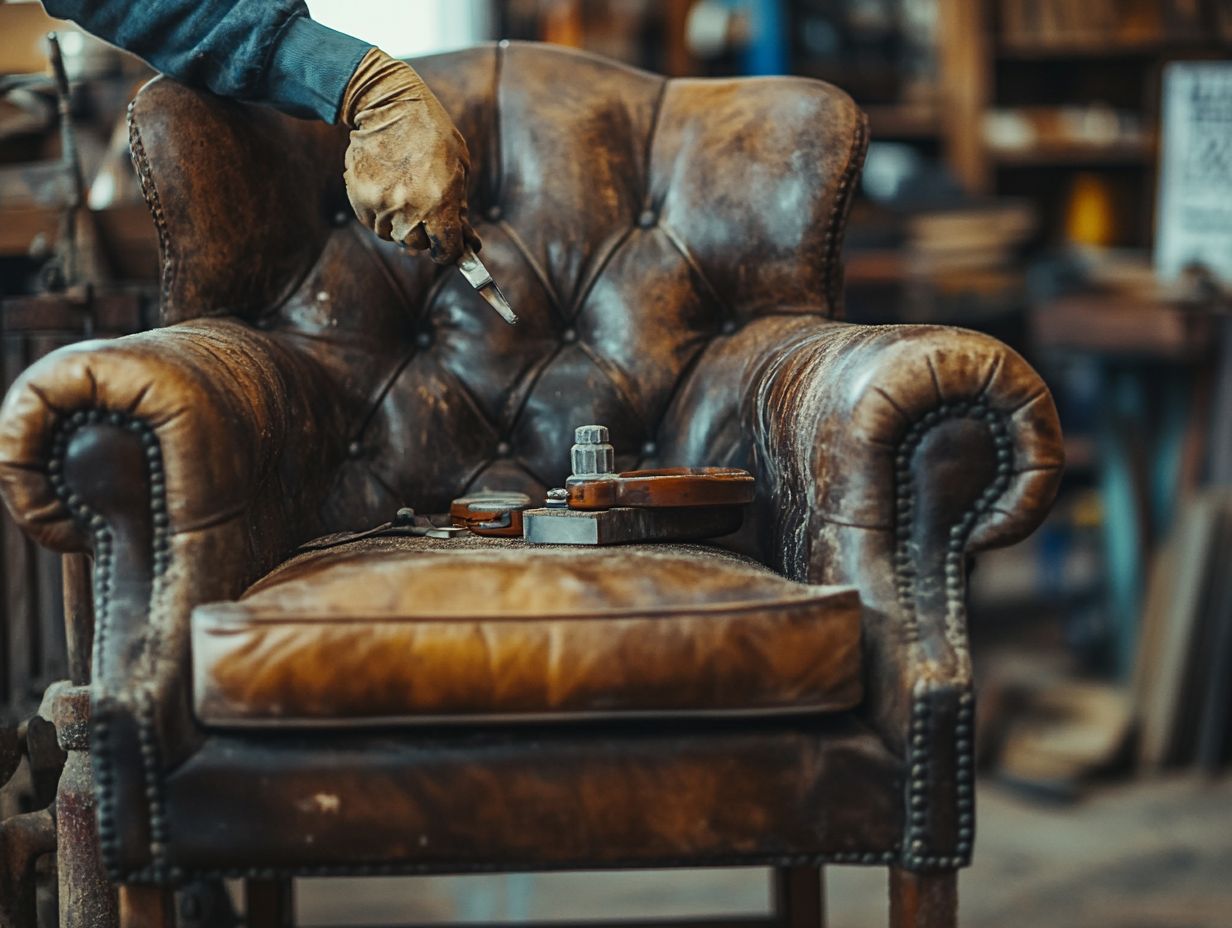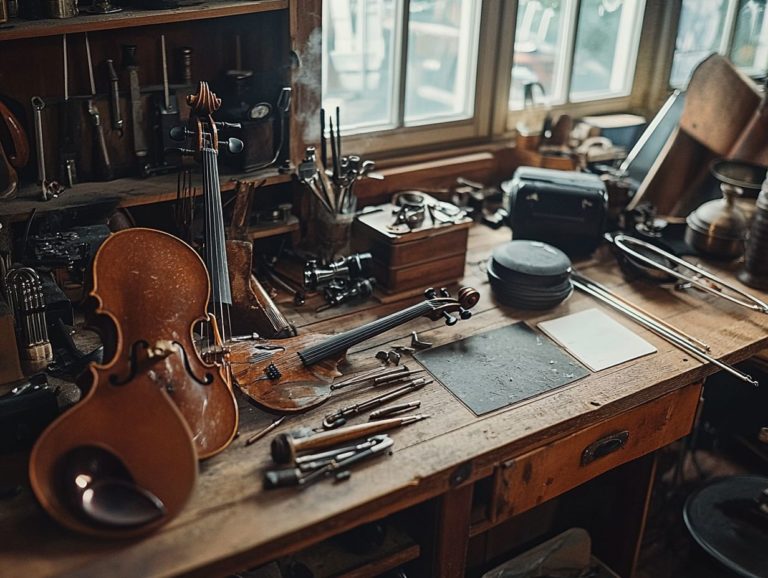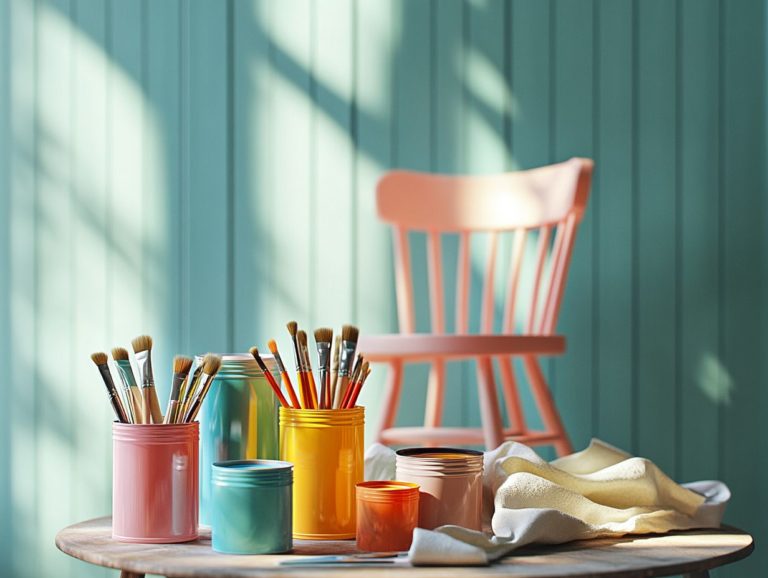How to Repair Vintage Leather Furniture
Vintage leather furniture exudes a timeless charm that captivates the senses. However, with age often comes inevitable wear and tear. Whether you’ve stumbled upon a beloved heirloom or a hidden gem at a thrift store, knowing how to care for and restore these pieces can significantly enhance their beauty and extend their lifespan.
This guide will empower you to identify common types of damage. Get ready to discover a simple, effective step-by-step guide that makes repairs a breeze! You will also find valuable maintenance tips to ensure your vintage leather remains in impeccable condition, along with a range of professional and DIY repair options.
Dive in now to revive your vintage treasures with expert advice on restoring leather and maintaining its beauty!
Contents
- Key Takeaways:
- Common Types of Damage
- Supplies and Tools Needed for Repair
- Steps to Repair Vintage Leather Furniture
- Maintenance and Care for Vintage Leather Furniture
- Alternative Options for Repairing Vintage Leather Furniture
- Frequently Asked Questions
- Wondering if you can fix cracks in your vintage leather furniture?
- What is the best method for repairing scratches on vintage leather furniture?
- How can I remove stains from my vintage leather furniture?
- Is it possible to restore the color of my faded vintage leather furniture?
- Can I repair tears in my vintage leather furniture?
- What is the best way to maintain the overall condition of my vintage leather furniture?
Key Takeaways:

- Inspect the damage on your vintage leather furniture before attempting any repairs.
- Maintain proper care; it’s essential for preserving their condition.
- Consider professional services or DIY alternatives if the damage is severe or extensive.
What Makes Vintage Leather Furniture Special?
Vintage leather furniture shows off the skill and care that went into making it, distinctly setting it apart from modern alternatives. It embodies the artistry of earlier eras, making it an exceptional choice for those with a discerning eye.
Its lasting quality, combined with the natural beauty of leather, enhances your living spaces. The stories and imperfections it carries like a rich leather patina speak volumes about its history. Brands like Pottery Barn and Mitchell Gold celebrate this uniqueness, thoughtfully incorporating vintage designs into their collections.
The durability of vintage leather furniture isn’t just about aesthetics; it’s a practical investment that can withstand the test of time with the right care. Regular conditioning and cleaning will keep its luster and softness intact while protecting it from scratches and wear.
The real allure lies in how these pieces age gracefully, developing a character that modern materials often lack. The inviting textures and varied hues encourage interaction, transforming any room into a warm and welcoming space.
Interior enthusiasts appreciate the contributions of well-crafted brands that prioritize sustainable practices and timeless designs, ensuring that vintage leather furniture remains a cherished staple in contemporary homes.
Common Types of Damage
Understanding the common types of damage that vintage leather furniture can endure is essential for maintaining its allure and ensuring its longevity. You might encounter issues like scratches in the leather, fading caused by sun exposure, or water damage all of which can diminish the aesthetic appeal of your cherished pieces.
By consulting with leather experts, you can gain invaluable insights into effective prevention strategies and repair techniques, helping your furniture retain its beauty over time.
Identifying and Assessing Damage
To effectively restore and maintain your vintage leather furniture, it s essential to accurately identify and assess any present damage, such as scratches or water stains. This step helps you choose the right cleaning products and shapes the approach needed for effective leather repair.
By closely examining the leather for signs of wear, such as discoloration or cracking, you can pinpoint areas that require special attention. A meticulous inspection may uncover not just surface-level issues, but deeper problems that could jeopardize the structural integrity of your cherished pieces.
Understanding the nuances of various vintage leather types ranging from aniline (a dye that penetrates the leather) to pigmented finishes (which are coated for extra protection) enables you to make informed choices about cleaning leather and selecting the best leather conditioner for your restoration. Selecting the right maintenance product is vital; it should align perfectly with the specific leather type and be capable of rejuvenating your furniture without causing further damage.
Through this careful evaluation and well-considered choices, your vintage leather furniture can be preserved and enjoyed for generations to come.
Supplies and Tools Needed for Repair

Having the right supplies and tools is essential for achieving success in leather restoration. This allows you to tackle everything from minor touch-ups to extensive repairs with ease.
Key items include a high-quality leather repair kit, leather conditioner, and leather cleaner. Specialized tools, such as leather dye a color product for matching the leather’s original shade are also important.
Brands like Guardsman Furniture Repair and Fibrenew provide specialized products tailored to meet your various leather care needs. This ensures your restoration efforts yield impressive results.
Essential Items for Repairing Vintage Leather Furniture
To effectively restore vintage leather furniture, ensure your toolkit for leather repair includes some essential items. A reliable leather conditioner and specialized cleaning products are critical.
A comprehensive repair kit complete with leather dye for precise color restoration is also necessary. These tools will help you tackle common issues and maintain the integrity of the leather.
Equipping yourself with a set of quality leather brushes is crucial for achieving an even application of cleaning solutions and conditioners. Don t overlook the importance of a patch kit; it’s vital for mending significant tears or cracks.
This allows for a seamless repair that preserves the aesthetic quality of your vintage piece. Having protective sprays on hand is important, as they shield the leather from future damage, including stains and water spots.
Using modern leather products will ensure each of these tools not only addresses immediate concerns but also enhances the durability and longevity of your cherished vintage leather furniture.
Steps to Repair Vintage Leather Furniture
Repairing vintage leather furniture requires a careful approach to restore its inherent beauty and functionality. You ll start with thorough cleaning and conditioning to rejuvenate the leather.
The process typically unfolds in several key steps:
- Assess the damage
- Gather the necessary supplies
- Execute the repair techniques recommended by leather experts to ensure optimal results.
Each of these steps is vital for achieving a successful restoration.
Step-by-Step Guide to Restoring and Repairing
A comprehensive step-by-step guide to restoring and repairing vintage leather furniture involves essential tasks such as cleaning the leather, applying conditioner, and addressing any scratches or imperfections with precision.
This structured approach ensures that every detail is attended to, preserving the furniture’s integrity and aesthetic allure.
To get started, gather essential supplies like a soft cloth, leather cleaner, and conditioner. These are crucial for an effective restoration process.
- Begin by removing any dirt or grime using the cleaner. Gently wipe in the direction of the grain to avoid damage.
- Once the surface is clean and dry, apply a high-quality conditioner in circular motions to replenish the leather’s natural oils and prevent it from drying out.
For scratches, consider using a leather repair kit. Follow the instructions closely for optimal results. This methodical approach not only revitalizes the furniture but also extends its lifespan, allowing you to enjoy its beauty for many years to come.
Maintenance and Care for Vintage Leather Furniture

Maintaining and caring for your vintage leather furniture is vital for preserving its longevity and beauty. This involves adopting regular practices that enhance leather care and prevent problems like fading or deterioration.
Effective leather maintenance includes routine cleaning, conditioning, and the application of protective products. This ensures your cherished pieces are safeguarded against environmental damage.
By committing to these practices, you can enjoy the elegance of your furniture for years to come. Act now to protect your investment in vintage leather!
Tips for Keeping Your Furniture in Good Condition
To keep your vintage leather furniture in pristine condition, following expert leather care tips is essential. Regularly applying leather conditioner and using high-quality leather cleaning products enhances the leather’s appearance and prevents long-term damage, preserving its luxurious feel.
Don t forget to regularly dust and vacuum your furniture to keep it looking its best! This simple step removes dirt and debris that can lead to unsightly scratches. When it s time for a deeper clean, choose a special leather cleaner that won t damage the material and won t strip away those precious natural oils. Be sure to steer clear of direct sunlight and heat sources, as these can cause fading and cracking over time.
For those stubborn stains that seem to have made themselves at home, act quickly with a soft cloth and a mild soap solution. By adopting these straightforward yet effective practices, you can ensure your leather remains soft, supple, and retains its timeless elegance for years to come.
Alternative Options for Repairing Vintage Leather Furniture
When repairing vintage leather furniture, you have a variety of options tailored to your specific needs. You can engage professional services that guarantee high-quality results or explore effective DIY alternatives that allow you to take matters into your own hands.
For those who prefer a hands-on approach, brands like Leather CPR provide kits designed to enable you to tackle repairs yourself, offering a satisfying blend of craftsmanship and personal touch.
Professional Services and DIY Alternatives
When weighing the options between professional services and DIY alternatives for leather repair, consider the extent of the damage and your personal expertise. Professional services offer precision and skill, while DIY alternatives, like those from Fibrenew, provide a cost-effective way to address repairs with a leather repair kit.
Professionals often have specialized training and access to high-quality materials, ensuring a finish that lasts especially important for your high-end leather goods. On the flip side, DIY methods enable you to tackle minor issues, like small scuffs or scratches, right from the comfort of your home.
You can easily find products such as leather dye (a colorant for leather) or repair adhesive (a strong glue for leather) at various stores, making it an accessible choice for those who prefer a more hands-on approach.
However, keep in mind that DIY repairs can yield mixed results, particularly if you lack experience or are dealing with more extensive damage. This could ultimately diminish the item’s value, so it’s essential to consider your skill level and the condition of the leather before diving in.
Frequently Asked Questions

Wondering if you can fix cracks in your vintage leather furniture?
Yes, it is possible to repair cracks in vintage leather furniture. You can use a leather repair kit or consult a professional for more severe damage.
What is the best method for repairing scratches on vintage leather furniture?
The best method for repairing scratches on vintage leather furniture is to use a leather repair kit specifically designed for this purpose. Follow the instructions carefully for the best results.
How can I remove stains from my vintage leather furniture?
There are several options for removing stains from vintage leather furniture, such as using a leather cleaner, mild soap and water, or a mixture of vinegar and water. Test a small, inconspicuous area first before applying to the entire piece.
Is it possible to restore the color of my faded vintage leather furniture?
Yes, you can restore the color of faded vintage leather furniture by using a leather dye or color restorer. Again, be sure to test on a small area first to ensure the desired result.
Can I repair tears in my vintage leather furniture?
Small tears in vintage leather furniture can be repaired with a leather repair kit. However, larger tears may require professional assistance to ensure a proper and long-lasting repair.
What is the best way to maintain the overall condition of my vintage leather furniture?
To keep your vintage leather furniture looking great, dust it regularly and wipe it down with a soft cloth. Avoid placing it in direct sunlight or near heat sources.
Use a leather conditioner to keep the leather soft and supple. Never use harsh chemicals on it, as this can harm its natural finish and beauty.






